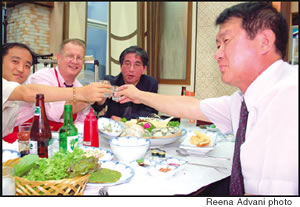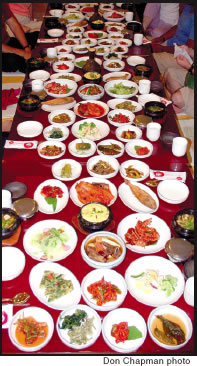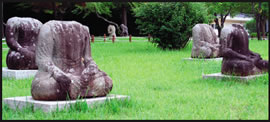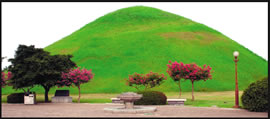A Soju Toast To South Korea

A soju toast at a seafood restaurant
in Busan with hosts from the Korea
Press Foundation, Mr. Kim, Mr. Lee
and Mr. Kim
This is the second in a three part series based on travelling in Korea, thanks to an East-West Center fellowship.
It was after being in South Korea for just a week — and more specifically after just a few shots of soju, a goes-down-easy distilled sweet potato liquor, at a seafood restaurant in Busan — that I announced to our hosts: “I love Korea!”
Back home and not currently under the influence of soju, I do indeed love Korea, and hope to return. What follows are a few traveler’s notes.
It’s only been in recent years that Korea has offered much for tourists — military dictatorships, which ran the country from 1953 until the late ’80s, tend not to encourage the flow of strange people and new ideas. And as the most invaded country in the world — in particular by China to the west and Japan to the east, but also Russia and Mongolia to the north — you can understand a bit of wariness with the outside world.
Among the main attractions I discovered: Seoul is a shopper’s paradise, especially with its huge markets such as Dongdaemun, and districts such as Insadong and Itawewon. And fans of Korean TV soaps and dramas from around Asia and the U.S. are booking trips to meet the stars and watch episodes being taped here.
Although Korea has been influenced in peace and war by China and Japan, Koreans take pride in the distinctness of their culture and the strength of their character. They see the world differently — the ocean to the east is not the Sea of Japan, as the rest of the world calls it, but the East Sea. To the west, it’s not the Yellow Sea, but the West Sea. Their language, too, is unlike any other. Hangeul is believed to be the only world language created by linguistic scholars — following an order from a Joseon Dynasty king in 1440 to create something separate from the Chinese characters they’d been using. Native speakers say “it’s easy, it’s phonetic.”

An endless variety of banchan
The people are as spicy as their kimchee. “We’re passionate, emotional,” our superb interpreter Uhm Do Yeon said. “We’re the Latin Americans of Asia.”
It’s seen in the nearly daily street demonstrations in Seoul, a vibrant city of 11 million. On my first day there, I cleverly placed myself between about 1,000 riot cops and several hundred highdecibel striking hospital workers. I saw another side of that passion at a Doosan Bears vs. Samsung Lions baseball game. Each side had four dancing girls on platforms in the stands, drummers, a whistle-blowing cheerleader, disco music and thousands of fans with Thundersticks who knew all of their team’s chants and cheers. It was a nine-inning frenzy, and as much fun as I’ve had at a baseball game. A seat 13 rows up from the field behind first base at Jamsil Stadium cost $5, and the hot dog with fresh-baked bun was one of the best I’ve tasted.
Koreans do food like nobody else. Every restaurant to which the fabulous Do took us included plates and plates of side dishes , banchan. And Koreans kimchee (to verbify a noun) just about anything — all manner of vegetables, even fish. It’s a healthy diet, some broiled meat, lots of veggies, with lettuce, sesame leaves and steamed cabbage used as wraps, plus lots of soups and rice. For every spicy dish, there’s a mild stew, a cup of custard or noodles.
Most restaurants only do a few dishes, but do them very well. A restaurant that features pork will feature a smiling pig cartoon on the sign. A smiling cow indicates a beef restaurant (bulgogi). Others feature noodles. At that bayside seafood restaurant in Busan, we were treated to some of the best sashimi I’ve ever tasted, as well as live octopus that squirmed in the dish (served with sesame oil and seeds, green onion and shoyu). Crunchy, kind of sweet. Then there were the fried
silk worms, which Do purchased from a street vendor. Kind of smokey, crunchy on the outside, soft inside. I had several. These exotic critters were washed down, by the way, with a couple of Hite beers and the aforementioned soju, a clear beverage Koreans have been drinking for 600 years.

Headless Buddhas at Gyeongjeu
The small town of Gyeongjeu in the south is well worth visiting. It’s the ancient capital of the Silla Dynasty, and numerous interesting sites include royal burial mounds and, high on a mountainside, the Seokguram grotto, where at a temple carved into the mountain monks chant before one of the finest Buddhas in Asia. At Gyeongjeu on the east side of the peninsula and on the west at Gongju, the ancient Baekje Dynasty capital, we saw Buddhas with heads chopped off — done when Confucianists took over, a reminder that religious intolerance is not unique to any people, region or faith. Both towns have fantastic National Museums that reveal an advanced culture in Korea for many centuries.
In Seoul, the excellent Korea War Memorial Museum tells the story of all of those invasions and the brave generals and admirals who repelled most of them. The Korean War section is quite compelling, and a stroll outside through the breezeway where America’s war dead are listed state by state may have you reaching for a tissue. Hawaii, by the way, had the highest per capita loss rate.
Unfortunately, there wasn’t time for the Kimchee Field Museum, which documents 200 different kinds of kimchee.
The capital blends modern high-rises and ancient history. The sprawling (and reconstructed) Gyeongbok-gung Palace grounds, just a short walk from my hotel, the Koreana (great location, food and service), was begun by a Joseon Dynasty king in 1394.
South Korea is roughly the size of Indiana, and while you can fly from Seoul to Busan, the 180-mph bullet train only takes a couple of hours and reveals lovely countryside with endless rice paddies and mountain ridges rising beyond. Do not rent a car. Although Koreans drive on the right side of the road, as in other Asian cities driving is an extreme sport. Seoul taxi drivers are quite adept. Leave it to the pros.
And if you want to visit the Demilitarized Zone (DMZ), don’t just show up. Only certified tour groups are allowed to bring visitors, and are easy to book through your hotel in Seoul.

One of the dozens of royal burial mounds
at Gyeongjeu
North Korea also offers one tourist opportunity for Westerners, the Gungan Mountain Resort. Buses from South Korea cross the DMZ on the eastern side of the country and take visitors to a very remote and controlled resort. Just watch what you say. A young South Korean woman, passing through a guard post on the North side as she returned home, had the temerity to ask a North Korean soldier: “Why is Kim Jung-Il the only fat man in North Korea?”
It only took South Korean officials three days to get her out of jail.
E-mail this story | Print this page | Comments (0) | Archive | RSS Comments (0) |
Most Recent Comment(s):





 Del.icio.us
Del.icio.us








